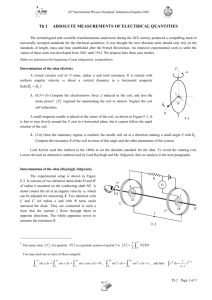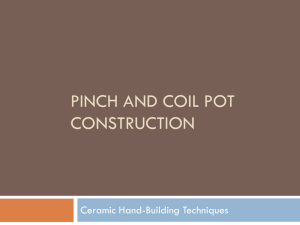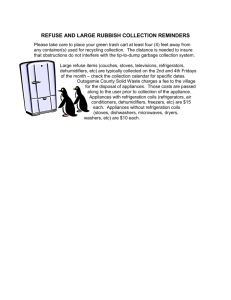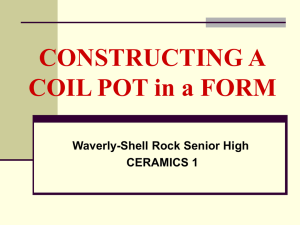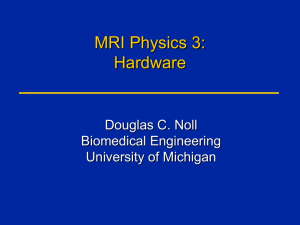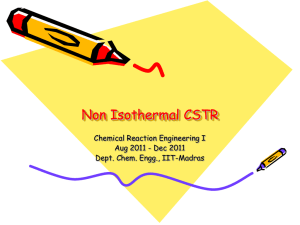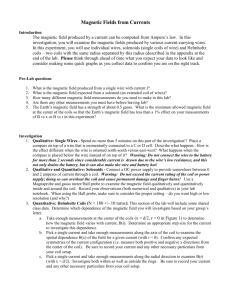section 23 82 16 - heating and cooling coils
advertisement
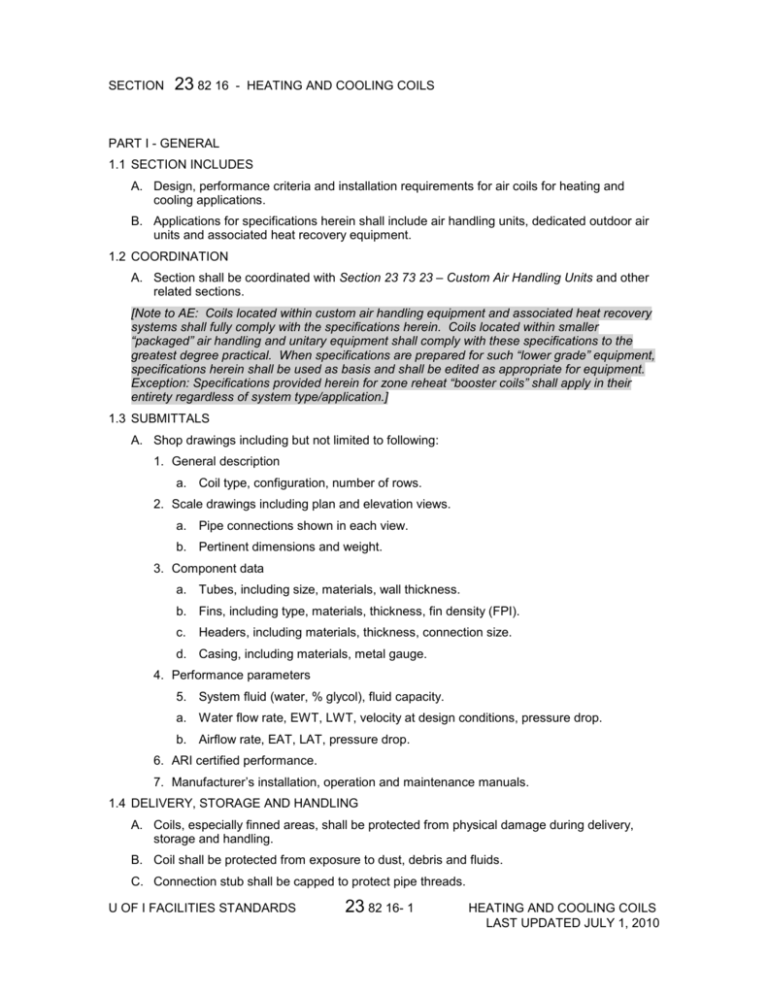
SECTION 23 82 16 - HEATING AND COOLING COILS PART I - GENERAL 1.1 SECTION INCLUDES A. Design, performance criteria and installation requirements for air coils for heating and cooling applications. B. Applications for specifications herein shall include air handling units, dedicated outdoor air units and associated heat recovery equipment. 1.2 COORDINATION A. Section shall be coordinated with Section 23 73 23 – Custom Air Handling Units and other related sections. [Note to AE: Coils located within custom air handling equipment and associated heat recovery systems shall fully comply with the specifications herein. Coils located within smaller “packaged” air handling and unitary equipment shall comply with these specifications to the greatest degree practical. When specifications are prepared for such “lower grade” equipment, specifications herein shall be used as basis and shall be edited as appropriate for equipment. Exception: Specifications provided herein for zone reheat “booster coils” shall apply in their entirety regardless of system type/application.] 1.3 SUBMITTALS A. Shop drawings including but not limited to following: 1. General description a. Coil type, configuration, number of rows. 2. Scale drawings including plan and elevation views. a. Pipe connections shown in each view. b. Pertinent dimensions and weight. 3. Component data a. Tubes, including size, materials, wall thickness. b. Fins, including type, materials, thickness, fin density (FPI). c. Headers, including materials, thickness, connection size. d. Casing, including materials, metal gauge. 4. Performance parameters 5. System fluid (water, % glycol), fluid capacity. a. Water flow rate, EWT, LWT, velocity at design conditions, pressure drop. b. Airflow rate, EAT, LAT, pressure drop. 6. ARI certified performance. 7. Manufacturer’s installation, operation and maintenance manuals. 1.4 DELIVERY, STORAGE AND HANDLING A. Coils, especially finned areas, shall be protected from physical damage during delivery, storage and handling. B. Coil shall be protected from exposure to dust, debris and fluids. C. Connection stub shall be capped to protect pipe threads. U OF I FACILITIES STANDARDS 23 82 16- 1 HEATING AND COOLING COILS LAST UPDATED JULY 1, 2010 PART 2 - PRODUCTS 2.1 GENERAL A. All Cooling coils and all Heating Coils shall be rated in accordance with ARI standard 410 and shall bear the ARI stamp or symbol. 2.2 WATER COILS A. General 1. Coils shall be of staggered tube, continuous parallel plate fin type. 2. Tubes shall be expanded into fins to form permanent bond. 3. Circuiting and connections shall be arranged to provide counter-flow of water and air. 4. “Turbulators” not allowed. 5. Coils shall be supplied with vent at high point and drain at low point of tube bundle. 6. Coils shall be fully drainable by gravity. 7. Coils shall have same end connections unless indicated otherwise in project documents. 8. Fluid velocity through tubes shall not exceed 5 FPS nor be less than 2.4 FPS under design conditions. 9. Coil thermal performance shall be determined based upon fluid media indicated on Schedule (e.g. water, 30% ethylene glycol solution). 10. If not otherwise scheduled, coil performance shall be based upon following parameters: a. 100% water for standard temperature air applications. b. 30% ethylene glycol solution for applications with coil freeze potential. 11. Coils shall be ARI rated with 0.0005 fouling factor. 12. Air pressure drop shall be as scheduled, maximum. 13. Water pressure drop shall be as scheduled, maximum. 14. Water pressure drop shall not exceed 30 ft. w.c. unless otherwise indicated in project documents. 15. Headers outside airflow shall be insulated in same manner as piping. B. Tubes 1. Tubes shall be seamless copper, 5/8” nominal OD with 0.035” wall thickness minimum. 2. When water velocity requirements cannot otherwise be satisfied, tubes may be ½” nominal OD with 0.032” wall thickness. 3. Return bends shall be one nominal wall thickness heavier than circuit tubing. C. Fins 1. Fins shall be aluminum for standard applications, 0.010” thick minimum. 2. Fins shall be flat or have low continuous corrugation, 0.065” peak-to-valley maximum. 3. Maximum fin density shall be 12 FPI for flat fins, 10 FPI for low corrugation type fins. 4. Fin edging shall be rippled or straight. Fin surfaces, edging shall not have lancing or other serrated enhancements. D. Headers 1. Coil headers, including intermediate headers, shall be constructed of Type L copper, minimum, or red brass. Cast iron headers not allowed. Each header shall have vent and drain. U OF I FACILITIES STANDARDS 23 82 16- 2 HEATING AND COOLING COILS LAST UPDATED JUNE 15, 2013 2. Connection stubs shall be schedule 40 carbon steel or red brass with MPT connections. Stubs shall be capped for shipping purposes. E. Casing and Supports 1. Casing shall have flanged connections unless indicated otherwise in project documents or dictated by specific application. 2. Casing, end supports and intermediate tube supports shall be G90 galvanized steel for heating applications and type 304 stainless steel for cooling applications. All formed sheet metal components shall be 16 gauge minimum. 3. Intermediate tube supports shall be provided for coils having finned tube length 48” or longer. Support shall be provided for each 48” tube length. 4. End supports and tube sheets shall have die formed belled tube holes or ferrules to minimize tube abrasion. F. Pressure Test 1. Completed coil assembly shall be pneumatically leak tested at 300 PSIG under water and shall be guaranteed for 200 PSIG working pressure. G. Non-Standard Applications 1. For non-standard applications, all component materials and thicknesses shall be selected for specific application. Factory-applied protective coating is a viable option. 2.3 CHILLED WATER COILS A. Coil shall satisfy requirements of WATER COIL section above with additional requirements: 1. Casing, end supports and intermediate tube supports shall be fabricated from type 304 stainless steel. All formed sheet metal components shall be 16 gauge minimum. 2. Fasteners shall be stainless steel. 3. Individual coil (i.e. continuous plate fins) shall not exceed 48-inch face height. 4. Coil shall be sized such that air velocity through “net free area” of coil face shall not exceed 500 FPM for coils with fin density 6-8 FPI, 475 FPI for coils with fin density 10 FPI, 450 for coils with fin density 12 FPI. 5. Performance of cooling coils served by campus central chilled water system shall be based upon following parameters: a. Entering chilled water temperature shall be 43 degrees F. b. Leaving chilled water temperature shall be 59 degrees F minimum. [Note to AE: For chilled water coils served by central system, LWT greater than 59F is encouraged. Design CHW “delta T” in excess of 16F results in “capacity charge” reduction.] 2.4 HOT WATER COILS A. Coil shall satisfy requirements of WATER COIL section above with additional requirements: 1. Coil casings, end supports and intermediate tube supports shall be fabricated from G90 galvanized steel. All formed sheet metal components shall be 16 gauge minimum. 2. Air velocity through net free area of coil shall not exceed 600 FPM. 3. If not otherwise scheduled, coil performance shall be based upon following parameters: a. Entering fluid temperature shall be 180 degrees F. b. Leaving fluid media temperature shall be 160 degrees F. 2.5 ZONE HOT WATER REHEAT COILS (a.k.a. BOOSTER COILS) A. Coil shall satisfy requirements of HOT WATER COIL section above with following modifications: U OF I FACILITIES STANDARDS 23 82 16- 3 HEATING AND COOLING COILS LAST UPDATED JUNE 15, 2013 1. Tubes shall be 5/8” nominal OD with 0.025” wall thickness minimum. a. Alternate: Tubes may be ½” nominal OD with 0.020” wall thickness minimum. 2. Fin thickness shall be 0.008” minimum. 3. Headers and connection stubs shall be type L copper minimum with MPT connections. Stubs shall be capped for shipping purposes. 4. Fluid pressure drop shall not exceed 20 ft. w.c. unless indicated otherwise in project documents. 5. Air velocity through full face area of coil shall not exceed 700 FPM. 6. Air pressure drop shall not exceed 0.33 in. w.c. unless indicated otherwise in project documents. 2.6 STEAM COILS [Note to AE: Steam heating coils are typically not allowed on new projects. They are reserved for direct coil replacement. However, limitations of existing infrastructure may make installation of steam coils(s) the only viable option. If so, approval from F&S Engineering shall be obtained prior to document preparation.] A. General 1. Steam coils shall be horizontal distributing type, vertical distributing type, or horizontal integral face and bypass (IFB) type as indicated in project documents. Standard nondistributing (serpentine) coils shall not be used. 2.7 STEAM DISTRIBUTING COILS A. General 1. “Tube-in-tube” distributing coil shall be used for all steam applications. 2. Fins shall be continuous parallel plate type. 3. Outer tubes shall be expanded into fins to form permanent bond. 4. Distributing coils shall have tubes oriented horizontally or vertically. 5. Coils with tubes oriented horizontally may be fed with steam from one end or both ends. 6. Coils with vertical tubes may be up-fed or down-fed. 7. For applications with potential exposure of coil to freezing conditions, face and bypass damper arrangement shall be provided unless indicated otherwise in project documents. [Note to AE: Face and bypass dampers are not necessarily required for distributing coils of small size. For horizontal tube coils “small size” may be on the order of 36” tube length. Allowable length can be increased somewhat by feeding the coil from both ends. For vertical tube distributing coils, allowable non-dampered coil size is substantially greater than that for horizontal tube coils. Thus, use of vertical tube coils is encouraged. An unfortunate disadvantage of vertical tube distributing coils is the overall height required to accommodate the steam/condensate header and associated piping at bottom of coil. With a bottom fed vertical coil there is no concern about providing clearance at top of coil.] [One should keep in mind that without the use of face and bypass dampers temperature control must be accomplished by modulation of steam flow rather than modulation of air flow. This results in variable steam pressure within the coil. One must remain mindful of the freeze potential associated with operation at very low steam pressure.] [Steam preheat coils shall be designed for exposure to 100% outdoor air regardless of design percent mixture of outdoor air and return air. Inevitably there will be times when the coil is exposed to 100% outdoor air as a result of control failure or some other unanticipated problem. Remember Murphy’s Law.] 8. If not otherwise scheduled, coil thermal performance shall be based upon 2 PSIG saturated steam. U OF I FACILITIES STANDARDS 23 82 16- 4 HEATING AND COOLING COILS LAST UPDATED JUNE 15, 2013 9. Air pressure drop shall be as scheduled, maximum. 10. Coils shall be supplied with vacuum breaker connection as applicable. 11. Headers outside airflow shall be insulated in same manner as piping. B. Tubes 1. Steam distributing coils shall utilize copper inner distributing steam tube centered in outer condensing tube and have properly spaced orifices angled in direction of condensate flow. 2. Tubes shall be seamless copper. Inner tube shall be 5/8” nominal OD. Outer tube shall be 1” OD nominal, minimum, sized to handle condensate load. Tube wall thickness shall be 0.049” minimum. C. Fins 1. Fins shall be aluminum for standard applications, 0.010” thick minimum. 2. Fins shall be flat or low continuous corrugation, 0.065” peak-to-valley maximum. 3. Fin density shall be 10 FPI maximum unless indicated otherwise in project documents. Maximum fin density of 8 FPI is recommended. 4. Fin edging shall be rippled or straight. Fin surfaces and edging shall not have lancing or other serrated enhancements. D. Headers 1. Headers shall be Type K copper, minimum. 2. Headers shall incorporate inner steam baffle to evenly distribute steam to all coil tubes. Condensate headers shall be sized to handle full design condensate load. 3. Condensate connection shall be located such that bottom of connection is no higher than bottom of lowest tube to ensure proper drainage. 4. Connection stubs shall be schedule carbon steel with MPT connections. Stubs shall be capped for shipping purposes. E. Casing and Supports 1. Casing, end supports and intermediate tube supports shall be G90 galvanized steel. All formed sheet metal components shall be 16 gauge minimum. 2. Casing shall have flanged supports/connections unless otherwise indicated within project documents or determined by application. 3. Intermediate tube supports shall be provided for coils having finned tube length 48” or longer. Support shall be provided for each 48” tube length. 4. End supports and tube sheets shall have die formed belled tube holes or ferrules to minimize tube abrasion. 5. For horizontal tube coils, tubes shall be pre-pitched in casing to facilitate condensate drainage. F. Pressure Test 1. Completed coil assembly shall be pneumatically leak tested at 190 PSIG under water and guaranteed for operating pressures to 150 PSIG. 2.8 IFB STEAM COILS (INTEGRAL FACE AND BYPASS) - HORIZONTAL DISTRIBUTING TUBE TYPE [Note to AE: If an IFB steam preheat coil is utilized it shall be of the horizontal tube steam distributing type. Vertical tube steam preheat coils shall not be used do to vulnerability to corrosion failure at lower ends of tubes and adjoining condensate return header. Vertical tube IFB steam coils also require substantial clearance both above and below coil. An air blender section shall be provided downstream of each IFB preheat coil in order to minimize U OF I FACILITIES STANDARDS 23 82 16- 5 HEATING AND COOLING COILS LAST UPDATED JUNE 15, 2013 air stream temperature stratification inherent with these types of coils. It is essential that manufacturer’s recommended clearances be provided upstream and downstream of each air blender. IFB coils are prone to creating “slices” or “jets” of alternating hot and cold air. If stratification is not effectively eliminated downstream of IFB type preheat coil in a typical draw through air handling unit application nuisance trips of the freeze protection thermostats at the face of the downstream cooling coil may result. It should be noted that use of an IFB coil is not necessarily the best design decision for all freeze protection applications. Cost and damper/linkage maintenance are among factors to be considered.] A. General 1. IFB coils shall consist of horizontally oriented alternating dampered finned tube cores and air bypass sections. 2. IFB coils shall maintain constant discharge air temperature regardless of variations of entering air temperature while operating at full steam pressure. B. Performance 1. Leaving air temperature measured three feet downstream of coil shall be maintained at temperature not varying more than 5 degrees F from average discharge temperature of coil. 2. Damper assembly shall be designed to maintain constant air flow volume not varying more than +/- 5% regardless of bypass damper position. 3. Coil/damper assembly shall include discharge shut-off dampers and damper blade and edge seals such that air bypassing finned tube cores shall not result in air temperature rise greater than 2 degrees F with steam pressure delivered to supply header at 5 PSIG. C. Dampers 1. Dampers shall be connected by readily accessible non-ferrous linkage, isolated from air stream and driven by actuator controlled by BAS. 2. Damper blades shall be fabricated from minimum 0.90” thick thermally reflective extruded anodized aluminum, pivoting on aluminum alloy damper rods housed in stainless steel or oil impregnated bronze bearings. Use of painted steel damper blades not permitted. 3. Blade edge seals shall be utilized where damper blades close to form seal. Blade edge seals shall be conservatively rated for worst case steam temperature. Blade edge seals shall be silicone or superior material rated for higher temperature. D. Frame 1. Flanged frame assembly shall be 14 gauge minimum G90 galvanized steel. Duct mounting holes and removable lifting lugs shall be provided. E. Finned Cores 1. Fins shall be continuous plate type. Outer tubes shall be expanded into fins to form permanent bond. 2. Each individual finned tube core shall be supported at tube ends by 16 gauge minimum tube sheet with copper ferrules to minimize tube abrasion. 3. Finned tube cores shall be isolated from bypass airstream by 16 gauge minimum sheet metal baffles. Use of moving sheet metal dampers as baffles not allowed. F. Tubes 1. Tubes shall be steam distributing type with copper inner distributing steam tube centered in outer condensing tube. Inner tube shall have properly spaced orifices angled in direction of condensate flow. 2. Tubes shall be seamless copper. Inner tube shall be 5/8” nominal OD. Outer tube shall be 1” OD nominal minimum, sized to handle condensate load. Tube wall thickness shall be 0.049” minimum. U OF I FACILITIES STANDARDS 23 82 16- 6 HEATING AND COOLING COILS LAST UPDATED JUNE 15, 2013 G. Fins 1. Fins shall be aluminum, 0.010” thickness minimum. H. Pressure Test 1. Completed coil assembly shall be pneumatically leak tested at 190 PSIG under water and guaranteed for operating pressures to 150 PSIG. I. Non-Standard Applications 1. For non-standard applications, all component materials and thicknesses shall be selected for specific application. J. Basis of Design: Marlo Stratomizer PART 3 – EXECUTION 3.1 INSTALLATION A. Protection 1. Coils shall be protected from physical damage during delivery, storage and handling. 2. Coils shall be protected from exposure to dust, debris and fluids. 3. Header connections shall be capped to protect pipe threads. B. Piping 1. Unions/flanges shall be installed at each coil pipe connection. 2. Steam and hot water coils shall be piped with adequate offsets to minimize stress at header connections due to thermal expansion. If not practical to provide adequate flexibility in this manner, flexible pipe connectors may be used, although their use is generally discouraged. 3. “Double fed” steam coils shall be piped such that pressure of steam supplied to each header is approximately equal. 4. Vacuum breaker shall be provided on steam supply piping near header inlet. Vacuum breaker also recommended at steam trap. 5. Full connection size condensate drip leg shall be provided. Vertical drop shall be 14” minimum from bottom of coil to trap inlet unless indicated otherwise in project documents. 6. Steam coils shall be trapped individually. 7. Cooling coil condensate drain lines shall be trapped and piped to drain independently. C. Location/Access 1. Whether located within air handling equipment or ductwork, adequate access shall be provided for inspection and cleaning of coils. 2. Location of coils above hard ceilings shall be avoided. 3. Ensure adequate clearance exists around coils relative to adjacent structures and/or building systems. Ensure adequate access to coil valves and piping. 4. Coils, especially cooling coils, shall not be installed above valuable furnishings, electrical equipment, electronic devices, etc. where leakage could result in costly damage. If impractical to do so, provision of protective drain pan is advised. D. Installation 1. Unless otherwise indicated within project documents, coils shall have flanged connections and shall be secured with threaded fasteners. Sheet metal screws shall not be used. 2. Fasteners and hardware shall be same material as connected components. Where connected components are dissimilar material, stainless steel fasteners shall be used. U OF I FACILITIES STANDARDS 23 82 16- 7 HEATING AND COOLING COILS LAST UPDATED JUNE 15, 2013 3. Structural supports shall be provided for stacked coils within air handling units. 4. When two or more cooling coils are stacked in an assembly, intermediate drain pans shall be provided. 5. Coils shall be installed dead level to facilitate full drainage by gravity. 6. Properly configured duct transitions shall be provided at duct mounted coils. 7. Coil fins shall be combed and straightened after installation is complete. E. Entering Air Requirement 1. Air streams of differing temperature shall be thoroughly mixed prior to entering coils. 2. During operation, coils shall be exposed to filtered air only. 3.2 CLEANING A. Coils shall be cleaned to satisfaction of AE and Owner. B. NADCA Standard ACR 2013 Assessment, Cleaning and Restoration of HVAC Systems shall be utilized by AE as basis for determining need for cleaning, extent thereof and methodology to be employed. C. Only non-hazardous non-toxic cleaning agents and materials shall be used. MSDS cut sheets shall be provided upon request. END OF SECTION 23 82 16 This section of the U of I Facilities Standards establishes minimum requirements only. It should not be used as a complete specification. U OF I FACILITIES STANDARDS 23 82 16- 8 HEATING AND COOLING COILS LAST UPDATED JUNE 15, 2013
